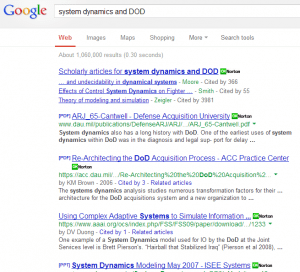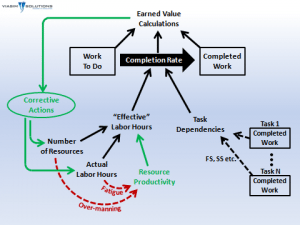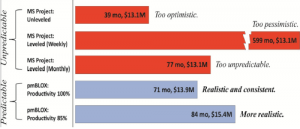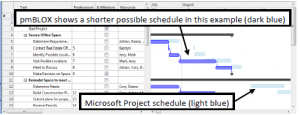System Dynamics is now for the rest of us!
by Stu Selip, Principal Consulting
That's great, but what is it? According to the System Dynamics Society
System dynamics is a computer-aided approach to policy analysis and design. It applies to dynamic problems arising in complex social, managerial, economic, or ecological systems -- literally any dynamic systems characterized by interdependence, mutual interaction, information feedback, and circular causalitySo, System Dynamics (SD) uses computers to simulate dynamic systems that are familiar to us in the realms of business and technology. OK that sounds great, but why am I writing about SD? A presentation by ViaSim Solution's (ViaSim) president J. Chris White and his ViaSim colleague Robert Sholtes at last Friday's InfoGov Community call piqued my interest, and I think SD will pique your interest too.
What do the big guys do with SD?
 Chris and Robert mentioned the long-time application of SD in the Department of Defense (DOD). A quick Google search revealed widespread use ranging from scholarly articles about simulating the control behavior of fighter planes to pragmatic approaches to re-architecting the acquisition process of the DOD itself. It looks like the DOD appreciates System Dynamics. Here is a clip from that search. Large enterprises can make good use of SD too. In a 2008 Harvard Business Review (HBR) article entitled Mastering the Management System by Robert S. Kaplan and David P. Norton, the authors identify the concept of closed loop management systems in linking strategy with operations, informed by feedback from operational results.
Chris and Robert mentioned the long-time application of SD in the Department of Defense (DOD). A quick Google search revealed widespread use ranging from scholarly articles about simulating the control behavior of fighter planes to pragmatic approaches to re-architecting the acquisition process of the DOD itself. It looks like the DOD appreciates System Dynamics. Here is a clip from that search. Large enterprises can make good use of SD too. In a 2008 Harvard Business Review (HBR) article entitled Mastering the Management System by Robert S. Kaplan and David P. Norton, the authors identify the concept of closed loop management systems in linking strategy with operations, informed by feedback from operational results.
Various studies done in the past 25 years indicate that 60% to 80% of companies fall short of the success predicted from their new strategies. By creating a closed-loop management system, companies can avoid such shortfalls.Their article, which you can see here with the right HBR subscription, discusses how this might be done, without explicitly mentioning System Dynamics.
What about the rest of us?
Most of the rest of us are involved in more mundane tasks than articulating corporate strategy. Many of us work on planning IT projects, with plans defined in Microsoft Project (MSP). How many MSP users have solid training in the tool? I'll wager that many practitioners have learned MSP by the "seat of their pants", never quite understanding why a small change to the options of a project plan has produced dramatically different timelines, or why subtle changes cause plans to oscillate between wildly optimistic, and depressingly pessimistic.  The ViaSim team spoke directly to these points by introducing us to pmBLOX, an SD-empowered MSP-like project planning tool that addresses MSP issues that cause us to lose confidence and lose heart. In this graphic, developed by ViaSim, the black arrows indicate inputs normally available to MSP users. The key differences are shown in the green and red arrows. With pmBLOX, project planners may specify corrective actions like adding workers to projects that are challenged. In addition, project planners can account for project delivery inefficiencies resulting from fatigue, or excessive staffing. You can watch Chris explain this himself, right here. At last, we will be able to respect Brook's Law, the central thesis of which is "adding manpower to a late software project makes it later". Dr. Fred Brooks expanded on this at length in The Mythical Man-Month, published by Addison Wesley in 1975. When I asked Chris about his experience with the challenges of mythical man-month project planning and non-SD project planning solutions he told me
The ViaSim team spoke directly to these points by introducing us to pmBLOX, an SD-empowered MSP-like project planning tool that addresses MSP issues that cause us to lose confidence and lose heart. In this graphic, developed by ViaSim, the black arrows indicate inputs normally available to MSP users. The key differences are shown in the green and red arrows. With pmBLOX, project planners may specify corrective actions like adding workers to projects that are challenged. In addition, project planners can account for project delivery inefficiencies resulting from fatigue, or excessive staffing. You can watch Chris explain this himself, right here. At last, we will be able to respect Brook's Law, the central thesis of which is "adding manpower to a late software project makes it later". Dr. Fred Brooks expanded on this at length in The Mythical Man-Month, published by Addison Wesley in 1975. When I asked Chris about his experience with the challenges of mythical man-month project planning and non-SD project planning solutions he told me
As we often see in the real world, sometimes "throwing people" at the problem puts the project further behind schedule. With these real-world corrective actions and productivity impacts, pmBLOX provides a framework for creating realistic and achievable plans. The biggest risk for any project is to start with an unrealistic baseline, which is often the case with many of today's simple (yet popular) project planning tools.
 Here is an example of the output of MSP and the output of pmBLOX for an actual DOD project. You can see how a minor change in an MSP setting (leveling) made some dramatic and scary changes in the project plan. Notice that the output of pmBLOX looks much more realistic and stable with respect to project plan changes.
Here is an example of the output of MSP and the output of pmBLOX for an actual DOD project. You can see how a minor change in an MSP setting (leveling) made some dramatic and scary changes in the project plan. Notice that the output of pmBLOX looks much more realistic and stable with respect to project plan changes.
What about the learning curve for pmBLOX?
There is good news here. pmBLOX designers adopted the MSP paradigm and allow for direct importing of existing MSP-based plans. Here is an example of how pmBLOX looks, and how it depicts the difference between its plan and the one suggested by MSP. To my eye, the interface is familiar, so adopting and transitioning to pmBLOX should not be very difficult.
and how it depicts the difference between its plan and the one suggested by MSP. To my eye, the interface is familiar, so adopting and transitioning to pmBLOX should not be very difficult.


